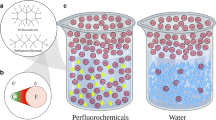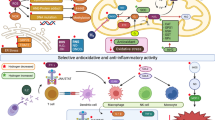Abstract
Purpose
Cisplatin is a widely used anti-cancer drug in the treatment of a wide range of tumors; however, its application is limited by nephrotoxicity, which is affected by oxidative stress. We have reported that molecular hydrogen (H2) acts as an efficient antioxidant (Ohsawa et al. in Nat Med 13:688–694, 2007). Here we show that hydrogen efficiently mitigates the side effects of cisplatin by reducing oxidative stress.
Methods
Mice were administered cisplatin followed by inhaling hydrogen gas (1% H2 in air). Furthermore, instead of inhaling hydrogen gas, we examined whether drinking water containing hydrogen (hydrogen water; 0.8 mM H2 in water) is applicable by examining oxidative stress, mortality, and body-weight loss. Nephrotoxicity was assessed by morphological changes, serum creatinine and blood urea nitrogen (BUN) levels.
Results
Inhalation of hydrogen gas improved mortality and body-weight loss caused by cisplatin, and alleviated nephrotoxicity. Hydrogen was detected in blood when hydrogen water was placed in the stomach of a rat. Consuming hydrogen water ad libitum also reduced oxidative stress, mortality, and body-weight loss induced by cisplatin in mice. Hydrogen water improved metamorphosis accompanying decreased apoptosis in the kidney, and nephrotoxicity as assessed by serum creatinine and BUN levels. Despite its protective effects against cisplatin-induced toxicity, hydrogen did not impair anti-tumor activity of cisplatin against cancer cell lines in vitro and tumor-bearing mice in vivo.
Conclusion
Hydrogen has potential for improving the quality of life of patients during chemotherapy by efficiently mitigating the side effects of cisplatin.





Similar content being viewed by others
References
Lebwohl D, Canetta R (1998) Clinical development of platinum complexes in cancer therapy: an historical perspective and an update. Eur J Cancer 34:1522–1534
Wolfgang GH, Dominick MA, Walsh KM, Hoeschele JD, Pegg DG (1994) Comparative nephrotoxicity of a novel platinum compound, cisplatin, and carboplatin in male Wistar rats. Fundam Appl Toxicol 22:73–79
Masuda H, Tanaka T, Takahama U (1994) Cisplatin generates superoxide anion by interaction with DNA in a cell-free system. Biochem Biophys Res Commun 203:1175–1180
Kruidering M, Van de Water B, de Heer E, Mulder GJ, Nagelkerke JF (1997) Cisplatin-induced nephrotoxicity in porcine proximal tubular cells: mitochondrial dysfunction by inhibition of complexes I to IV of the respiratory chain. J Pharmacol Exp Ther 280:638–649
Baliga R, Zhang Z, Baliga M, Ueda N, Shah SV (1998) In vitro and in vivo evidence suggesting a role for iron in cisplatin-induced nephrotoxicity. Kidney Int 53:394–401
Zhang JG, Lindup WE (1993) Role of mitochondria in cisplatin-induced oxidative damage exhibited by rat renal cortical slices. Biochem Pharmacol 45:2215–2222
Khynriam D, Prasad SB (2002) Changes in glutathione-related enzymes in tumor-bearing mice after cisplatin treatment. Cell Biol Toxicol 18:349–358
Matsushima H, Yonemura K, Ohishi K, Hishida A (1998) The role of oxygen free radicals in cisplatin-induced acute renal failure in rats. J Lab Clin Med 131:518–526
Taguchi T, Nazneen A, Abid MR, Razzaque MS (2005) Cisplatin-associated nephrotoxicity and pathological events. Contrib Nephrol 148:107–121
Pabla N, Dong Z (2008) Cisplatin nephrotoxicity: mechanisms and renoprotective strategies. Kidney Int 73:994–1007
Yao X, Panichpisal K, Kurtzman N, Nugent K (2007) Cisplatin nephrotoxicity: a review. Am J Med Sci 334:115–124
Ajith TA, Usha S, Nivitha V (2007) Ascorbic acid and alpha-tocopherol protect anticancer drug cisplatin induced nephrotoxicity in mice: a comparative study. Clin Chim Acta 375:82–86
Weijl NI, Elsendoorn TJ, Lentjes EG et al (2004) Supplementation with antioxidant micronutrients and chemotherapy-induced toxicity in cancer patients treated with cisplatin-based chemotherapy: a randomised, double-blind, placebo-controlled study. Eur J Cancer 40:1713–1723
Ohsawa I, Ishikawa M, Takahashi K et al (2007) Hydrogen acts as a therapeutic antioxidant by selectively reducing cytotoxic oxygen radicals. Nat Med 13:688–694
Nagata K, Nakashima-Kamimura N, Mikami T, Ohsawa I, Ohta S (2009) Consumption of molecular hydrogen prevents the stress-induced impairments in hippocampus-dependent learning tasks during chronic physical restraint in mice. Neuropsychopharmacology 34:501–508
Lee S, Moon SO, Kim W et al (2006) Protective role of L-2-oxothiazolidine-4-carboxylic acid in cisplatin-induced renal injury. Nephrol Dial Transplant 21:2085–2095
Fukuda K, Asoh S, Ishikawa M, Yamamoto Y, Ohsawa I, Ohta S (2007) Inhalation of hydrogen gas suppresses hepatic injury caused by ischemia/reperfusion through reducing oxidative stress. Biochem Biophys Res Commun 361:670–674
Samali A, Cotter TG (1999) Measurement of cell death in culture. In: Jenkins N (ed) Animal cell biotechnology. Humana Press, Totowa, pp 155–164
Kuhlmann MK, Burkhardt G, Kohler H (1997) Insights into potential cellular mechanisms of cisplatin nephrotoxicity and their clinical application. Nephrol Dial Transplant 12:2478–2480
Esterbauer H, Schaur RJ, Zollner H (1991) Chemistry and biochemistry of 4-hydroxynonenal, malonaldehyde and related aldehydes. Free Radic Biol Med 11:81–128
Fang J, Sawa T, Akaike T et al (2003) In vivo antitumor activity of pegylated zinc protoporphyrin: targeted inhibition of heme oxygenase in solid tumor. Cancer Res 63:3567–3574
Siddik ZH (2003) Cisplatin: mode of cytotoxic action and molecular basis of resistance. Oncogene 22:7265–7279
Wang D, Lippard SJ (2005) Cellular processing of platinum anticancer drugs. Nat Rev Drug Discov 4:307–320
Kelland L (2007) The resurgence of platinum-based cancer chemotherapy. Nat Rev Cancer 7:573–584
Appenroth D, Frob S, Kersten L, Splinter FK, Winnefeld K (1997) Protective effects of vitamin E and C on cisplatin nephrotoxicity in developing rats. Arch Toxicol 71:677–683
Naziroglu M, Karaoglu A, Aksoy AO (2004) Selenium and high dose vitamin E administration protects cisplatin-induced oxidative damage to renal, liver and lens tissues in rats. Toxicology 195:221–230
Giri A, Khynriam D, Prasad SB (1998) Vitamin C mediated protection on cisplatin induced mutagenicity in mice. Mutat Res 421:139–148
De Martinis BS, Bianchi MD (2001) Effect of vitamin C supplementation against cisplatin-induced toxicity and oxidative DNA damage in rats. Pharmacol Res 44:317–320
Baldew GS, van den Hamer CJ, Los G, Vermeulen NP, de Goeij JJ, McVie JG (1989) Selenium-induced protection against cis-diamminedichloroplatinum(II) nephrotoxicity in mice and rats. Cancer Res 49:3020–3023
Silva CR, Greggi Antunes LM, Bianchi ML (2001) Antioxidant action of bixin against cisplatin-induced chromosome aberrations and lipid peroxidation in rats. Pharmacol Res 43:561–566
Atessahin A, Yilmaz S, Karahan I, Ceribasi AO, Karaoglu A (2005) Effects of lycopene against cisplatin-induced nephrotoxicity and oxidative stress in rats. Toxicology 212:116–123
Sener G, Satiroglu H, Kabasakal L et al (2000) The protective effect of melatonin on cisplatin nephrotoxicity. Fundam Clin Pharmacol 14:553–560
Lynch ED, Gu R, Pierce C, Kil J (2005) Reduction of acute cisplatin ototoxicity and nephrotoxicity in rats by oral administration of allopurinol and ebselen. Hear Res 201:81–89
Yildirim Z, Sogut S, Odaci E et al (2003) Oral erdosteine administration attenuates cisplatin-induced renal tubular damage in rats. Pharmacol Res 47:149–156
Sogut S, Kotuk M, Yilmaz HR, Ulu R, Ozyurt H, Yildirim Z (2004) In vivo evidence suggesting a role for purine-catabolizing enzymes in the pathogenesis of cisplatin-induced nephrotoxicity in rats and effect of erdosteine against this toxicity. Cell Biochem Funct 22:157–162
Nisar S, Feinfeld DA (2002) N-Acetylcysteine as salvage therapy in cisplatin nephrotoxicity. Ren Fail 24:529–533
Dickey DT, Muldoon LL, Doolittle ND, Peterson DR, Kraemer DF, Neuwelt EA (2008) Effect of N-acetylcysteine route of administration on chemoprotection against cisplatin-induced toxicity in rat models. Cancer Chemother Pharmacol (in press)
Hathcock JN, Azzi A, Blumberg J et al (2005) Vitamins E and C are safe across a broad range of intakes. Am J Clin Nutr 81:736–745
Li Y, Schellhorn HE (2007) New developments and novel therapeutic perspectives for vitamin C. J Nutr 137:2171–2184
Sauer H, Wartenberg M, Hescheler J (2001) Reactive oxygen species as intracellular messengers during cell growth and differentiation. Cell Physiol Biochem 11:173–186
Liu H, Colavitti R, Rovira II, Finkel T (2005) Redox-dependent transcriptional regulation. Circ Res 97:967–974
Bjelakovic G, Gluud C (2007) Surviving antioxidant supplements. J Natl Cancer Inst 99:742–743
Miller ER 3rd, Pastor-Barriuso R, Dalal D, Riemersma RA, Appel LJ, Guallar E (2005) Meta-analysis: high-dosage vitamin E supplementation may increase all-cause mortality. Ann Intern Med 142:37–46
Salganik RI (2001) The benefits and hazards of antioxidants: controlling apoptosis and other protective mechanisms in cancer patients and the human population. J Am Coll Nutr 20:464S–472S
Fontanari P, Badier M, Guillot C et al (2000) Changes in maximal performance of inspiratory and skeletal muscles during and after the 7.1-MPa Hydra 10 record human dive. Eur J Appl Physiol 81:325–328
Hayashida K, Sano M, Ohsawa I et al (2008) Inhalation of hydrogen gas reduces infarct size in the rat model of myocardial ischemia–reperfusion injury. Biochem Biophys Res Commun 373:30–35
Cai J, Kang Z, Liu WW et al (2008) Hydrogen therapy reduces apoptosis in neonatal hypoxia-ischemia rat model. Neurosci Lett 441:167–172
Buchholz BM, Kaczorowski DJ, Sugimoto R et al (2008) Hydrogen inhalation ameliorates oxidative stress in transplantation induced intestinal graft injury. Am J Transplant 8:2015–2024
Ritskes-Hoitinga M (2004) Nutrition of laboratory mice. In: Hedrich H (ed) The laboratory mouse. Elsevier, London, pp 463–479
Kajiyama S, Hasegawa G, Asano M et al (2008) Supplementation of hydrogen-rich water improves lipid and glucose metabolism in patients with type 2 diabetes or impaired glucose tolerance. Nutr Res 28:137–143
Acknowledgments
We thank Blue Mercury Inc. (Tokyo, Japan) for the generous gift of hydrogen water. This work was supported by grant from the Ministry of Education, Culture, Sports, Science and Technology of Japan (19659331, S. O. and 20500723 to N. N.-K.).
Conflict of interest statement
Dr. Ohta is a director of Mitos Co. Ltd. (Kawasaki, Japan), and a scientific adviser to Blue Mercury Inc. (Tokyo, Japan). Blue Mercury Inc. supplied the fresh hydrogen water used in this study and has donated a research division to our institute.
Author information
Authors and Affiliations
Corresponding author
Rights and permissions
About this article
Cite this article
Nakashima-Kamimura, N., Mori, T., Ohsawa, I. et al. Molecular hydrogen alleviates nephrotoxicity induced by an anti-cancer drug cisplatin without compromising anti-tumor activity in mice. Cancer Chemother Pharmacol 64, 753–761 (2009). https://doi.org/10.1007/s00280-008-0924-2
Received:
Accepted:
Published:
Issue Date:
DOI: https://doi.org/10.1007/s00280-008-0924-2




